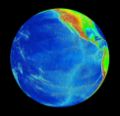Difference between revisions of "Fundamental resources/Water"
| Line 10: | Line 10: | ||
Over 70% of the surface of the Earth is covered by water, with the average depth of the oceans being 3.8 kilometres (12,430 ft) {{en}} we live on what is primarily a water world. Wasting the fresh water that falls on the surface of the land should of course be avoided wherever possible, but having enough fresh water in any place ultimately comes down to energy, rather than water itself. | Over 70% of the surface of the Earth is covered by water, with the average depth of the oceans being 3.8 kilometres (12,430 ft) {{en}} we live on what is primarily a water world. Wasting the fresh water that falls on the surface of the land should of course be avoided wherever possible, but having enough fresh water in any place ultimately comes down to energy, rather than water itself. | ||
| − | As long as we have large amounts of renewable energy at our disposal (which we do - see the [[#Energy|energy section]]), we can always create fresh water as required from seawater, using reverse osmosis, membrane bioreactors, or more energy-efficient methods like slow sand filters and nanofiltration. However, being careful with what we already have reduces the energy required for this. | + | As long as we have large amounts of renewable energy at our disposal (which we do - see the [[#Energy|energy section]]), we can always create fresh water as required from seawater, using {{wp|Reverse_osmosis|reverse osmosis}}, {{wp|Membrane_bioreactor|membrane bioreactors}}, or more energy-efficient methods like slow sand filters and nanofiltration. However, being careful with what we already have reduces the energy required for this. |
Besides, there is a way to turn this problem completely on its head. What if, instead of needing to reserve energy to treat wastewater, treating wastewater was a way of ''generating'' energy? This is the promise of [[Energy#Bacteria|microbial fuel cells]]. One investigation found that the organic impurities in wastewater contain 9.3 times as much energy as is needed to treat the water<sup>[http://scitation.aip.org/getabs/servlet/GetabsServlet?prog=normal&id=JLEED9000130000002000045000001&idtype=cvips&gifs=yes&ref=no]</sup>. It should be possible to integrate microbial energy-harvesting systems with water treatment facilities to create a self-sustaining facility that creates both clean water and clean electricity. | Besides, there is a way to turn this problem completely on its head. What if, instead of needing to reserve energy to treat wastewater, treating wastewater was a way of ''generating'' energy? This is the promise of [[Energy#Bacteria|microbial fuel cells]]. One investigation found that the organic impurities in wastewater contain 9.3 times as much energy as is needed to treat the water<sup>[http://scitation.aip.org/getabs/servlet/GetabsServlet?prog=normal&id=JLEED9000130000002000045000001&idtype=cvips&gifs=yes&ref=no]</sup>. It should be possible to integrate microbial energy-harvesting systems with water treatment facilities to create a self-sustaining facility that creates both clean water and clean electricity. | ||
Revision as of 22:32, 6 July 2010
Water is life. To secure a high standard of living for all people, we must secure an abundant, renewable supply of water for drinking, cleaning, cooking, irrigation, heating and cooling. The purpose of this page is to show how this is possible using currently existing technologies.The intelligent use of mankind's water resources is not just an environmental issue; it is a public health issue. Drinking contaminated water is one of the most common causes of cholera, typhoid, diarrhoea, hepatitis A, dysentery and river blindness. Luckily, there is no need for this to happen, other than scarcity-based economics. We have all the technology to provide abundant pure water for all of humanity.
People standing on a 70% water planet and talking about a 'water shortage' is absurd; though through synthetic scarcity, we may run into a shortage of intelligent ways to purify and distribute water.
Abundance of water
Over 70% of the surface of the Earth is covered by water, with the average depth of the oceans being 3.8 kilometres (12,430 ft) – we live on what is primarily a water world. Wasting the fresh water that falls on the surface of the land should of course be avoided wherever possible, but having enough fresh water in any place ultimately comes down to energy, rather than water itself.
As long as we have large amounts of renewable energy at our disposal (which we do - see the energy section), we can always create fresh water as required from seawater, using reverse osmosis  , membrane bioreactors
, membrane bioreactors  , or more energy-efficient methods like slow sand filters and nanofiltration. However, being careful with what we already have reduces the energy required for this.
, or more energy-efficient methods like slow sand filters and nanofiltration. However, being careful with what we already have reduces the energy required for this.
Besides, there is a way to turn this problem completely on its head. What if, instead of needing to reserve energy to treat wastewater, treating wastewater was a way of generating energy? This is the promise of microbial fuel cells. One investigation found that the organic impurities in wastewater contain 9.3 times as much energy as is needed to treat the water[1]. It should be possible to integrate microbial energy-harvesting systems with water treatment facilities to create a self-sustaining facility that creates both clean water and clean electricity.
Sources of clean water
Suspended particles can be removed from water by passing them through a slow sand filter with layers of gravel and sand. This is within the reach of all the World's people, as it requires no input of energy and no technological sophistication. A slow sand filter makes water safer for drinking, but does not fully remove all microscopic pathogens. UV light is a clean and effective way to kill water-borne pathogens and requires no chemicals, only a little electricity. As LEDs get cheaper and more energy-efficient, the use of UV-emitting LEDs to sterilize water becomes more and more attractive. It would be a relatively simple matter to fit homes with the means to catch rainwater, pass it through a slow sand filter and sterilize it with UV light. In many temperate and tropical climates, this would provide the inhabitants of the home with an abundance of water. This decentralization of water-production would eliminate the need for complicated municipal water-distribution systems and would make individuals more independent and resilient in the case of disasters.
Atmospheric water generators  condense water from the air. This water is clean and ready to drink. It is interesting to note that even very dry air contains about 5ml water per cubic meter of air, so even in a desert, enough water to sustain a person could be condensed from the air.
condense water from the air. This water is clean and ready to drink. It is interesting to note that even very dry air contains about 5ml water per cubic meter of air, so even in a desert, enough water to sustain a person could be condensed from the air.
Nanofilters are an effective way of filtering out both suspended particles (which cause unpleasant tastes, smells and discoloration) and pathogens. The Tata Swach is a device that uses nanofilters to give very pure water. It retails for only $21. However, like other filters, it eventually clogs with impurities.
Filters made of carbon nanotubes, small enough to let water molecules pass though, while blocking salt particles, impurites and pathogens, have recently reduced the price of desalination of sea water by 75% [2]. As 97% of the world's water is in the oceans, and unsalted water is needed for most human purposes, a practical method of desalination is a huge key to making Spaceship Earth work for all its inhabitants. IBM are conducting research into nanofiltration-based desalination [3]. Filtration using nanotubes that are too small to become clogged is being investigated [4].
Using less water
In the USA in 2006, the average water use per person per day was 575 litres. Compare this with 149 litres in the UK and 4 litres in Mozambique. Peter Gleick has said that 50 litres of water is sufficient for a person[5].
Using composting toilets rather than flush toilets would save 26.7%[6] of water use in the home. Composting toilets are also a source of fertilizer for growing food - and electrodes could even harvest electricity from the bacteria they contain (see Energy).
With the concern about conserving water in recent years, designers have developed toilets, sinks, dishwashers and washing machines that use a fraction of the water used by conventional designs.
However, reducing the domestic use of water is only a small part of the puzzle. 69% of water used by humans goes towards irrigation for agriculture [7]. A method of agriculture that uses 2% of the water of drip irrigation is discussed in the page about food.

